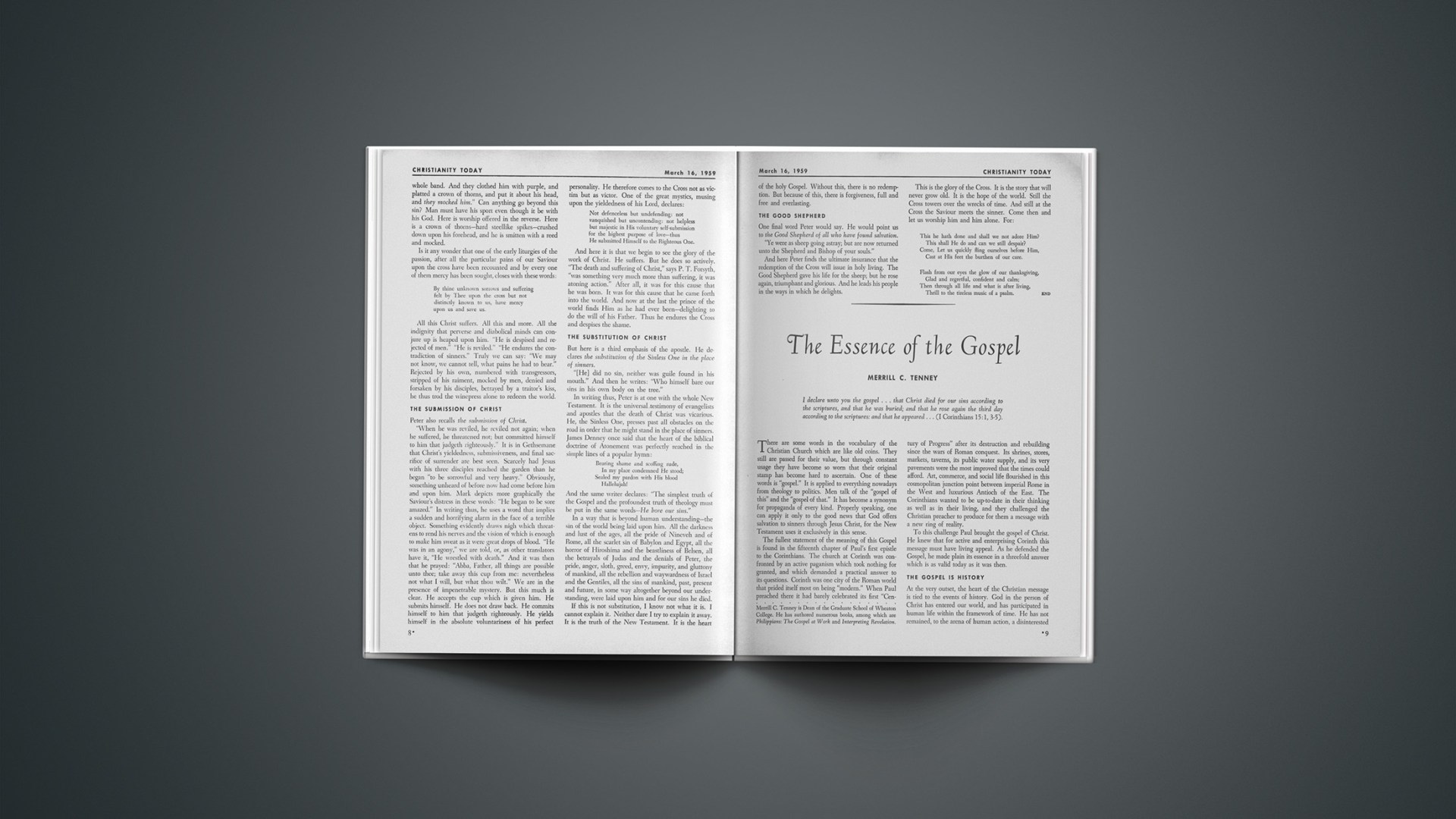I declare unto you the gospel … that Christ died for our sins according to the scriptures, and that he was buried; and that he rose again the third day according to the scriptures: and that he appeared … (1 Corinthians 15:1, 3–5).
There are some words in the vocabulary of the Christian Church which are like old coins. They still are passed for their value, but through constant usage they have become so worn that their original stamp has become hard to ascertain. One of these words is “gospel.” It is applied to everything nowadays from theology to politics. Men talk of the “gospel of this” and the “gospel of that.” It has become a synonym for propaganda of every kind. Properly speaking, one can apply it only to the good news that God offers salvation to sinners through Jesus Christ, for the New Testament uses it exclusively in this sense.
The fullest statement of the meaning of this Gospel is found in the fifteenth chapter of Paul’s first epistle to the Corinthians. The church at Corinth was confronted by an active paganism which took nothing for granted, and which demanded a practical answer to its questions. Corinth was one city of the Roman world that prided itself most on being “modern.” When Paul preached there it had barely celebrated its first “Century of Progress” after its destruction and rebuilding since the wars of Roman conquest. Its shrines, stores, markets, taverns, its public water supply, and its very pavements were the most improved that the times could afford. Art, commerce, and social life flourished in this cosmopolitan junction point between imperial Rome in the West and luxurious Antioch of the East. The Corinthians wanted to be up-to-date in their thinking as well as in their living, and they challenged the Christian preacher to produce for them a message with a new ring of reality.
To this challenge Paul brought the gospel of Christ. He knew that for active and enterprising Corinth this message must have living appeal. As he defended the Gospel, he made plain its essence in a threefold answer which is as valid today as it was then.
The Gospel Is History
At the very outset, the heart of the Christian message is tied to the events of history. God in the person of Christ has entered our world, and has participated in human life within the framework of time. He has not remained, to the arena of human action, a disinterested spectator, sitting comfortably at a distance in the galleries where the world’s sins and miseries cannot affect him; nor does he deal with human life by remote control. From the very beginning God has taken an active part in the life of men, and now in Christ he has become a sharer in it. It is this action that Paul sums up in four great facts.
The first is, “Christ died.” Outside the walls of Jerusalem, beneath a lowering April sky, Jesus hung on a cross between two thieves. One of his disciples had betrayed him, and the rest, disheartened and fearful, had scattered in every direction. The priesthood of his nation had repudiated him as a heretic and lawbreaker, and had agitated for his removal. The Roman governor, though he pronounced Jesus innocent of any crime, was finally compelled to order his execution for reasons of expediency. There was no logical reason for his death, except that men had borne hatred and malice toward him.
The manner of his death was strange. Darkness covered the earth while he was on the cross. An earthquake shook the ground when he expired, and the thick veil of the temple was tom in two from top to bottom. The centurion who commanded the execution squad on duty at the cross, and who had witnessed many such scenes, was moved to say, “Truly this man was the son of God.”
The Gospels emphasize the physical realities of his death. Pain, thirst, and loss of blood weakened his frame until at last he expired; and after death the blood and serum that flowed from his side when the soldier pierced it attested the fact that he really had died.
The second fact of the Gospel is that Christ was buried. This statement seems like a truism, for dead men are generally buried. Paul, however, was not simply multiplying words. The burial is an attestation of the reality of Jesus’ death. His body would never have been given to his followers if Pilate had not been satisfied that he was no longer alive. Those who prepared it for burial also were sure of this, or they would have done their utmost to revive it. They simply realized that Jesus had suffered the common lot of all men.
These two facts can be accepted by all persons without a qualm because they occur in the normal realm of things. All die and all are buried. There is thus far no exception for Christ, and one wonders why participation in these experiences should be included in a Gospel of hope. The third statement, however, removes the question: “he rose again the third day.”
The fact of the Resurrection is stated as calmly and as certainly as the events of death and burial. The inspired writer does not put it in a different category; he reckons it to be equally as certain as the other two, in spite of its seeming improbability. Can such a phenomenal statement be true?
The fact of the Resurrection was verified by the empty tomb. All of the records agree that on the morning of the third day after the crucifixion the tomb of Jesus was open and empty. Who had a motive for entering it? Not Jesus’ enemies; for if they could show that his body was still mouldering in the tomb under the Roman seal, they would be able to give the lie effectually to any idea that he was supernatural. His friends could not have removed the body, for they were not psychologically prepared to overpower the guard and take it; or, if they had done so, some rumor of their action would have leaked out later into the Church and eventually to the world at large.
The only alternative is that the Resurrection took place as the Gospels say it did. The stone was rolled away by angelic power, disclosing that the tomb was vacant except for the graveclothes which Jesus had laid aside for the robes of glory.
The fourth fact is that he appeared to a number of persons after the Resurrection. Six different occasions are listed in this passage. The first was a private appearance to Cephas, or Peter. Peter should have known Jesus if he saw him, for he had been intimately associated with him and had not been separated from him more than a few days. Besides, Peter had special business to transact with Jesus. The denial rankled in Peter’s mind, and he wanted an opportunity to tell Jesus of his repentance. Surely he would not have been satisfied to talk to an apparition, or to confide his repentance to an illusion.
“The twelve” is a collective term for the band of disciples, whether all of them were present together or not. The reality of the risen Christ did not depend on the testimony of one man but was verified by the majority of the original twelve, some of whom did not believe in the possibility of his resurrection and were boldly critical of the reports that the women and others had given about his appearances.
The testimony of the 500 brethren provided adequate numerical witness; for if the majority of them were still surviving in Paul’s day, there would be no lack of corroboration for the historical fact. If a court of law will accept the united testimony of two or three witnesses, the testimony of three hundred or more living men certainly ought to be convincing.
The appearance to James was specially significant. This James was undoubtedly the Lord’s brother who became the moderator of the church in Jerusalem. During Jesus’ life he was an unbeliever like the rest of the brethren, but a change had come over him at the time of the Resurrection. Some very compelling reason must have made him change his attitude. Had the Cross been the terminus of Jesus’ life, James and the other brothers might well have felt that their lack of confidence in Jesus was justified. To them he would have been a misguided dreamer who made embarrassing promises, attempted to pose as a Messiah, and who came to an unfortunate end because of his own lack of political sense. When he appeared to James he gave convincing proof of the truth that he had spoken, and James could not resist belief in him.
The final witness is Paul himself, for he says, “he appeared to me also.” Paul’s conversion on the road to Damascus was effected by a direct contact with the living Christ who spoke to him from heaven. The appearance differed from these others because Jesus was not standing immediately by him, nor was he visible to Paul’s companions. In Paul’s life, however, this was the pivotal experience that reversed his whole course of action. Its reality is unquestionable.
These four statements indicate that God has done something in history which cannot be accounted for by the ordinary laws of cause and effect. History is not a closed circuit of action in which God cannot intervene. In Christ eternity has intersected time. While the ensuing events are as historical as the defeat of Rommel at El Alamein, they are also supernatural in quality. Looking back on them, we can see that by them God has done the unusual.
The Gospel, then, is founded on facts which are verifiable by human testimony, but which are not of human causation. As the late Dr. J. Gresham Machen once said, “The Gospel is not something that was invented, but something that happened.” It is not an ingeniously contrived complex of thought which produces its effect by influencing men’s minds in a historical vacuum. The Gospel is tied in with the total process of history. It cannot be disregarded by any consistent student of human life.
The Gospel Is Theology
Facts, however, are of small use unless they are interpreted. A chemist may fill his notebooks with observations from his experiments, but his work is of little value unless he can correlate the results and deduce from them principles that will guide his thinking for further scientific advance. In similar fashion these facts of the Gospel call for an interpretation that we call theology. Theology is the orderly formulation of the meaning of God’s revelation to us in Christ. The facts tell us what the basis of the Gospel is; theology tells us why God acted as he did.
The theology of the Gospel is stated very simply in this text: “Christ died for our sins according to the scriptures … and … he rose again the third day according to the scriptures.” The qualifying phrases state the main theological content.
The first of these, “for our sins,” gives the reason for the death of Christ. What is the relation between a man who died on a Roman cross in Palestine 19 centuries ago and the inhabitants of the modern world? What possible relevance can there be between the vast organization of human life today and the obscure execution that took place outside the walls of Jerusalem? The answer is that this person was not merely a Jewish prophet who fell afoul of the civil authorities, nor a visionary who was ahead of his time, nor a social reformer who suffered an unfortunate martyrdom. He was the Son of God who came into history that he might take upon himself our sins, and make himself an offering for them to God. “God was in Christ, reconciling the world unto himself” (2 Cor. 5:19).
Sin is man’s central problem. His disobedience has cut him off from the fellowship of God because God cannot tolerate evil in His presence. His very nature is contrary to it. Unless some way is found of removing this obstacle, man will be sundered from God forever. Since his very life depends upon contact with God, separation from God will mean the frustration of all his efforts, and the. dilution of existence into utter meaninglessness.
Reconciliation to God must be made on some basis which will remove the old guilt and which will open the door once again to fellowship. Who can take the initiative? Here is a paradoxical situation. Nobody can represent man adequately who is not human, and who cannot speak as one of our race. On the other hand, who of our race is adequate to stand before God as our representative? If all are tainted by sin, no one of us would be acceptable before him.
Furthermore, how can God reveal himself satisfactorily to men? Through what medium can he make plain his love and his judgment, his removal of sin and his program for those whom he saves? How can he speak to man with the voice of deity in the language of humanity? If he wrote his message in the sky, man would not have the knowledge to comprehend it. If he spoke by an audible voice, it would be misunderstood. If he used only some supernatural sign, it would be discounted by unbelief. How could the paradox of atonement and the paradox of revelation be solved at the same time?
God has found a way to resolve these difficulties: “Christ died for our sins.” In him deity and humanity united perfectly. His perfection provided a representative acceptable to God and adequate for men. His voluntary assumption of suffering with us and for us, and his participation in our alienation from God atoned for our sin. From the divine standpoint, his action revealed the love and justice of God: love in the sacrifice, justice in the penalty of death that he endured for us. No theology, however profound, can plumb the depths of this complex relationship; yet the simple statement of the text provides the answer for it.
The second half of our theology is stated in verse 4: “He rose again the third day according to the scriptures.” A dead Christ would be impotent to accomplish any good for us, however great his sacrifice might have been. The Resurrection demonstrated his supernatural character, for he could not be held by death. It proved that the divine righteousness had prevailed over the worst that sin could do, and that Jesus still lives to carry out the results of what he accomplished by his death. God accepted his work of revelation and reconciliation and endorsed it by bringing him back to life.
If these theological implications of the facts are to be known, how are they to be communicated? If they are only inferences made by witnesses, inferences drawn by others might be equally valid. There would be no norm of interpretation; each man would decide for himself what the death and resurrection of Christ would mean. Paul uses the phrase, “according to the scripture.” The revelation spoken by God through the prophets has given to us a sure key to the explanation of the revelation given in the life and works of his Son. Isaiah (53:5) said, “he was wounded for our transgressions, he was bruised for our iniquities; the chastisement of our peace was upon him; and with his stripes we are healed.” The Old and New Testaments both bear authentic witness to Christ and interpret his work for us. The Scriptures preserve the facts of God’s salvation and set the mold of their interpretation.
The Gospel Is Power
When Einstein propounded his world-famous formula, E = MC2, he deduced it from the observed facts of the universe by a mathematical process. Not until it was applied did it bring in the scientific developments that produced our atomic age. A correct theology may be based on historic reality, and may follow all the laws of logic, but it will remain only a formula if it is not put to work. The writer of this passage spoke not only as an historian who was recording accurately events that happened, nor only as a theologian who was seeking to explain the events in terms of the relation of God to man, but he spoke as a Christian on whose life these events had a profound effect. “He appeared to me” Paul said, and he insisted that Christ died for our sins. The death and resurrection of Christ were to him an intense personal concern.
As he reviewed his career he remembered how he had begun it with bitter enmity in his heart toward Christ. He had persecuted the church of God unmercifully, and had hounded the Christians from Jerusalem to Damascus, dragging them to trial before religious authorities and flinging them into prison. At the time of writing these words he was engaged in propagating the very faith which he once destroyed. The old hardness and hatred had vanished. He had become warmly devoted to Christ and was an outstanding champion of His cause. What had made this tremendous change?
The knowledge of the Gospel had effected this transformation. He said in the later epistle to the Romans, “I am not ashamed of the gospel of Christ; for it is the power of God unto salvation to every one that believeth; to the Jew first, and also to the Greek” (Rom. 1:16). The grace of God in Christ transformed this persecutor into a preacher. It gave the dynamic for his almost unbelievable labors that took him by land and sea through the length of the Mediterranean world as a preacher and missionary. It was the power that transformed other lives also, so that their united witness produced the conquering Church.
In Today’S World
Neither human nature nor human circumstances have altered radically since Paul first proclaimed this Gospel in the streets and market places of Corinth. The sensuality and materialism of that city, its commercial enterprise and activity were essentially no different from the world of today. There may be new facilities for sin, but there are no new sins. Lust, greed, envy, hatred, and unbelief have not changed. The same Gospel that was valid in Corinth applies to America: “Christ died for our sins according to the scriptures, and he rose again.” It is written indelibly in history, for the stark Cross and the empty tomb, however they be explained, are undeniable facts. It is the core of Christian theology, for God has not rescinded his revelation in the Scriptures, and their words are of final authority in interpretation. It is still the power of God unto salvation, as hundreds whose lives have been redeemed from evil and from wretchedness can testify.
Merrill C. Tenney is Dean of the Graduate School of Wheaton College. He has authored numerous books, among which are Philippians: The Gospel at Work and Interpreting Revelation.
I Too Arose
When Jesus rose on Easter morn He did not rise alone; For all the ransomed Heaven-born Ordained to flank His throne Arose in Him that Eastertide Eternal praise to give— For, as in Adam all had died, In Christ all now should live.
Yes, even I was in that throng Whose number none can count; I, too, shall sing the victors’ song On Zion’s glorious mount. Our Second Adam, Christ our King, Had conquered all my foes; Now, resurrected, I can sing, In Him I, too, arose!
HARRISON PALMER










